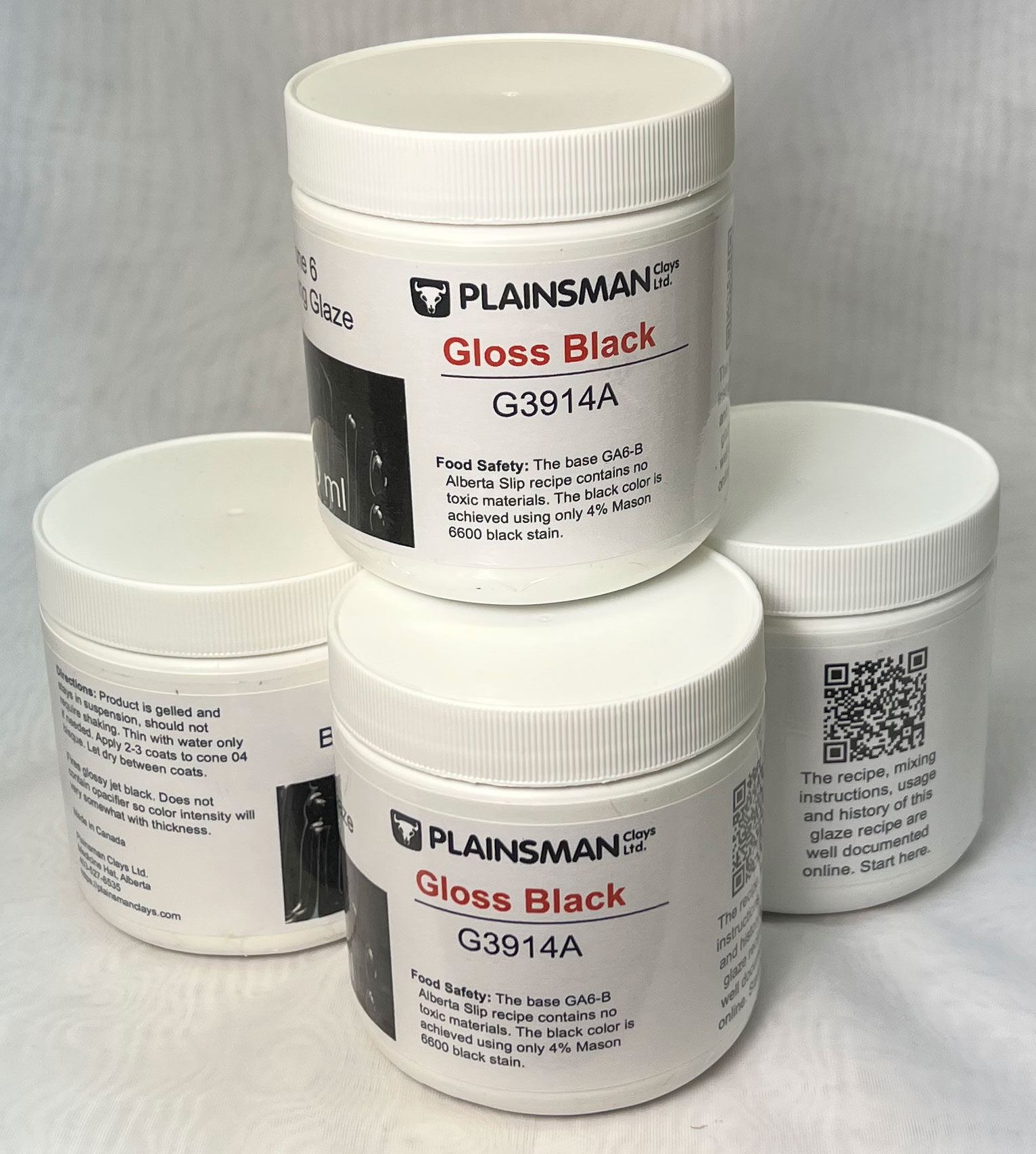| Monthly Tech-Tip | No tracking! No ads! |
Alberta Slip based black passed all four leaching tests
This is the G3914A recipe on Plainsman M340 test tiles. They were fired at cone 6 using the PLC6DS schedule. We tested them in four different caustic liquids (using the GLLE test), there is no sign of leaching on any of them. This recipe contains only 4% black stain, that is enough to stain the base GA6-B glaze to a jet black. The surface has a unique iridescence that is not found in any other glossy black we have used.
Related Pictures
Two methods to make your own low SG brushing glaze.

This picture has its own page with more detail, click here to see it.
Dipping glaze applies and dries in seconds. Brushing glazes dry slowly and dry hard. Brushing glazes simply have gum in the recipe, dipping glazes typically do not. This is the Alberta Slip cone 6 base, made jet black with 4% black ceramic stain (our code G3914A). We normally mix this as a dipping glaze but I have made a 500ml jar of low SG brushing version using both of the following methods. These methods will work for almost any glaze recipe (for those having exceptionally high clay content less Veegum is needed).
1) Shake together, in a plastic bag, 340g of mixed glaze powder with 5g of Veegum and 5g of CMC gum. Add that to 440g of water in a kitchen blender and mix on high speed until it gels (the gums resist mixing so the highest speed for at least 30 seconds is needed to prevent lumps).
2) Take 680g of dipping glaze (assuming it is about 50:50 water:powder you get 340g of dry), put that in the blender with another 80g of water and proceed as in method 1. Less total water is being used because the dipping glaze might not be exactly 50:50 water:powder. During mixing, if it gels too much add the extra 20g of water.
Cone 6 oil-spot glaze effect, what works and does not work?

This picture has its own page with more detail, click here to see it.
Simulating a white-on-black oil-spot effect at cone 6 oxidation proved to be a matter of repeated testing (that got me past some misconceptions). Stopping to think about the results at each step and keeping a good audit trail with pictures, in my account at insight-live.com, really helped. I had three black glazes: G2934BL satin (G2934 with black stain), G2926BB super-gloss (G2926B with black stain) and G3914A Alberta Slip black. Going on a hunch, I mixed up a bucket of the G3914A first (with some gum to help it survive second-coating without lifting). Rather than just try any white, I created G3912A by substituting as much CaO and MgO as possible for SrO in the G2934Y base. I later learned this to be an error, SrO reduces the surface tension, I should have used MgO (the G2934Y is a high-MgO glaze so it would have been fine as-is)! As you can see on the far right, this white still worked (at cone 5, 6, 7, 8). Why? There is another factor even more important. The effect only works on the Alberta Slip black. But its LOI is not higher than the others. And it worked even after ball milling. So I need to continue to work on this to learn more about why this works.
Two black cone 6 glazes recipes. One leaches metals. Why?

This picture has its own page with more detail, click here to see it.
We tested susceptibility to leaching of a stained glaze (top two) and another colored with raw metal oxides (bottom two) using the GLLE test (they were left overnight in vinegar and lemon juice). All the samples were fired using the C6DHSC firing schedule. The top two are G3914A (GA6-B Alberta Slip base with an addition of only 4% Mason 6600 black stain). There is no sign of leaching (Drano and bleach likewise did not affect it). The bottom two are G2926B transparent with 10% manganese dioxide and 5% copper oxide added (a common way to get black). The G2926B transparent base is proven, its surface shows no signs of gloss-loss in any testing we have done. But with manganese and copper added it is a very different story. Not only was this not nearly as black, but the vinegar and lemon juice matted and blued the top sections. Obviously, a ceramic stain added to the Alberta Slip GA6-B base is a far better way to make a leach-resistant black. Is it better than adding the black stain to G2926B? Yes, because far less is needed since the GA6-B base already has plenty of pigmentation.
Got a Question?
Buy me a coffee and we can talk

https://backup.digitalfire.com, All Rights Reserved
Privacy Policy

